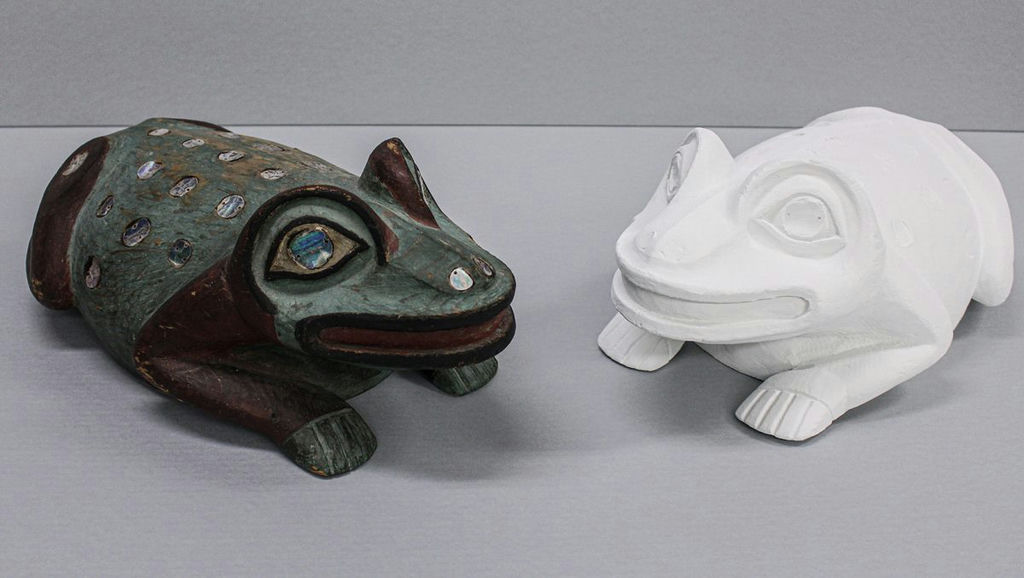A 19th-century clan helmet of carved yellow cedar in the Northwest Coast collection of the Hudson Museum at the University of Maine has been introduced to 21st-century 3D printing technology in an attempt to replicate the artifact for future repatriation and educational purposes.
More form the News
The museum, in collaboration with UMaine’s Advanced Structures and Composites Center and Intermedia Program, received a $14,600 seed grant from the UMaine Arts Initiative for the project, “Technology and Tradition: Shaping Indigenous Collections for the Future.” The funding supports the creation of a 3D printed prototype replica, and the work of UMaine student intermedia artists to do final surface finishing and treatment, and painting to match the original artifact.
The object, a Frog Clan Helmet painted in green and red pigments and inlaid with abalone shell discs that were originally attached to a textile, is requested for repatriation by the Central Council of the Tlingit and Haida Indian Tribes of Alaska. Harold Jacobs, cultural resources specialist for the Central Council, granted permission to do the prototype project, which has the potential to facilitate the return of the artifact to the Indigenous community and allow the Hudson Museum to retain the culturally important replica for educational purposes.
The project also allows the Hudson Museum to develop a proof of concept for collection replication projects, helping to create protocols for replication projects with Indigenous communities and to provide other collecting institutions with technical information on 3D scanning, printing and techniques for creating surfaces that resemble the original artifact or object, says director Gretchen Faulkner. The project draws on UMaine’s world-class expertise in 3D printing at the Composites Center and engages UMaine Intermedia Program students’ skills in a museum setting.
Composites Center research engineers Jonathan Roy and Alexander Cole led the scanning, digitizing and 3D printing of the prototype, created out of a durable thermoplastic that can be sanded to a smooth finish. Intermedia graduate students Luke McKinney, Reed Hayden and Anna Martin are collaborating on the model finishing, painting and surface treatment to replicate the appearance of the original carving.
The creation of the Frog Clan Helmet replica, including photos and time lapse video of its scanning and printing, will be the focus of a Hudson Museum exhibit in late July.
The Tlingit Frog Clan Helmet is subject to the Native American Graves Protection and Repatriation Act, and repatriation of the object has been requested by the Central Council of Tlingit and Haida Indian Tribes of Alaska. The Hudson Museum has repatriated unassociated funerary remains and this piece is part of an ongoing request from the Central Council of Tlingit and Haida Indian Tribes of Alaska.
The Frog Clan Helmet was part of a 1982 bequest to UMaine from the estate of William P. Palmer III, which included an extraordinary gift of Precolumbian objects that ranged from Olmec to Aztec, and an assemblage of Northwest Coast masks, potlatch bowls, Chilkat textiles and items made for sale outside the community. The Hudson’s Northwest Coast Collections include deaccessioned museum holdings and objects acquired from Native American art dealers. Collection documentation indicates that Palmer acquired the Frog Helmet from a California collector.
Tlingit clan hats and helmets were crest objects, referred to as at.oow, displaying either clan symbols or crest animals. Among the Tlingit, such helmets are communally owned and kept in the possession of the head of the clan, and the tribe has actively worked with museums throughout the United States for their return.
Objects of cultural patrimony returned through Native American Graves Protection and Repatriation Act have been reintegrated into federally recognized Native American tribes and Native Alaskan and Hawaiian villages and organizations’ ceremonial and religious practices.
Hats are worn and danced by clan leaders on important ceremonial occasions, the death of clan leaders and potlatches. In the late 19th and early 20th century with efforts to eradicate Indigenous languages, traditions, and ceremonial and religious practices, many were collected by museums or sold to collectors, according to Faulkner. Today, the return of these objects has brought healing to Tlingit communities and reconnected them to their cultural traditions of their ancestors.
“Technology and Tradition: Shaping Indigenous Collections for the Future” was one of five funded projects to receive seed grants as part of the new Arts Initiative launched in 2021 by the UMaine Office of the Vice President for Research and Dean of the Graduate School to increase resources and support for the arts, reinforcing their significance and enhancing their visibility on campus and beyond.
Subscribe to AM Chronicle Newsletter to stay connected: https://bit.ly/3fBZ1mP
Follow us on LinkedIn: https://bit.ly/3IjhrFq
Visit for more interesting content on additive manufacturing: https://amchronicle.com/


